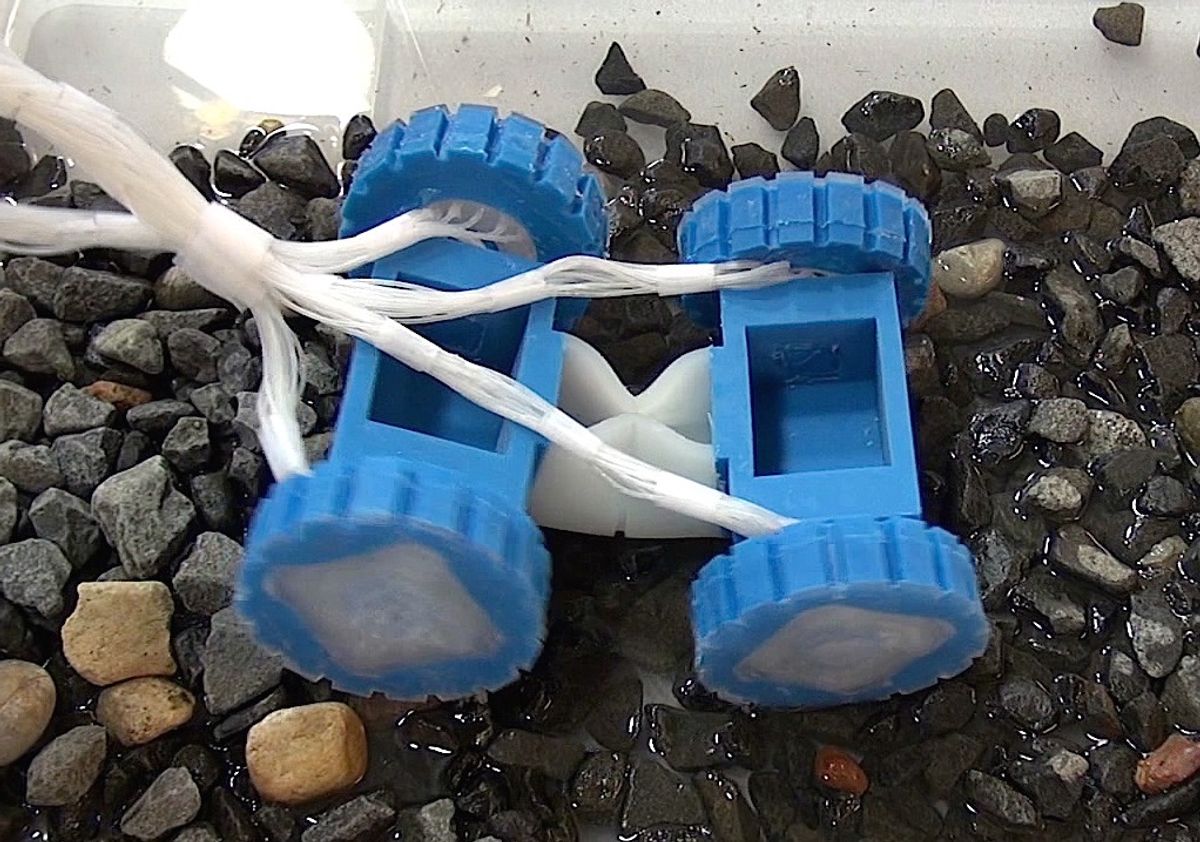There’s a reason why you don’t see rotary motors or joints in nature: at anything above the molecular scale, too much stuff has to be permanently attached to too much other stuff for any of it to be freely rotating in the way a mechanical wheel or axle is. The more bioinspiration you want to work into a robot, the more of an issue this becomes, which is why it’s particularly impressive that researchers at Rutgers University in New Brunswick, N.J., have managed to put four silicone-based wheels with air-powered motors inside of them on a robot that’s as soft as a Crocs shoe.
Most squishy robots with pneumatic muscles exert force on the environment through bending: a pneumatic chamber that’s constrained on one side will curve when inflated, which generates enough motion that robots can walk around on legs and pick things up with grippers. Directional motion like this is very common in nature: most of your muscles work this way, exerting force one way over a finite distance, in cooperative opposition to another muscle that exerts force the other way. You also have muscles that work together in peristalsis, in which synchronized contractions and relaxations generates a propagating wave. This is how you swallow food, and also how worms and snails move.
Professor Aaron Mazzeo’s group at Rutgers has cleverly adapted this peristaltic motion into a rotary actuator: a motor that can turn continuously, powered only by pneumatic actuators inflating and deflating themselves in sequence. The video is 5 minutes long, but worth watching to understand how this works:
Essentially, the motor is made of two parts. You’ve got a thing called a stator that doesn’t move but causes another thing called a rotor to rotate continuously. The rotor has some notches cut into it, and the stator has a series of pneumatic chambers that fit into those notches if you inflate them. The chambers are arranged in groups of four, with each group of four being offset from the next group of four by 22.5 degrees. When one group of pneumatic chambers in the stator is inflated, the chambers lock into the center of the notches of the rotor. Deflating those chambers and inflating the next group in sequence will recenter the notches of the rotor on the next group of chambers, rotating it by 22.5 degrees.
The diagram below shows a sequence of snapshots of how this works for two different kinds of rotary actuators. I’m sorry to say that it’s a horribly confusing diagram, but here’s what’s important:
- The Type 1 actuator (on the top) has an inside rotor and outside stator, while the Type 2 actuator (on the bottom) is reversed, with an outside rotor and an inside stator. Basically, Type 1 has a rotating inside axle, while Type 2 makes a rotating outside wheel.
- The diagram for some reason uses an arrow to illustrate how a point on the Type 1 rotor is moving from step to step, and a red dot to illustrate the same motion of the Type 2 actuator.
- The numbers show which group of pneumatic chambers are inflating. The four blobby bits are all of the chambers in one group inflating simultaneously (even though only one chamber is numbered), and there are four different groups that inflate in numerical sequence. Uninflated chambers are the little lines between the inflated ones.
It may be complex, but the robot has no rigid components. Zero. It survived a drop test from 8x its height with no problems, but I feel like the researchers were probably being conservative, since it looks so bouncy. Since it’s completely soft, it also works as its own suspension, making it good at adapting to rough terrain, and without any electronics, it’s perfectly at home in the water. It looks like it can probably handle payloads, and be scaled up or down, perhaps significantly. Since most of the robot was made using 3D printed molds and soft lithography, it’s (relatively) inexpensive, and the researchers suggest that it might be appropriate for educational science or engineering kits, or around children, animals, in hospitals, or anywhere else where squishy is good.
The obvious problem here is that you’ve still got, oh, about a bajillion little tubes that connect the robot to some kind of unspecified source of pressurized air that is almost certainly not squishy. This research is not attempting to solve that problem, but in the past, we’ve posted about ways in which air pressure could be reversibly generated onboard a robot like this.
In terms of specific applications, here’s what the researchers have to say:
“Future wheeled robots with elastomeric components might find uses in search and rescue missions in extreme environments or over varied terrains, such as an irregular tunnel that requires a compliant body with large deformation, or a rugged lakebed under water. With the low sensitivity of elastomers to magnetic fields, wheeled robots or rotary joints made of elastomers might facilitate travel in space with limited exposure to radiation and cold. Another application might include the manipulation of objects during magnetic resonance imaging. Lacking sharp or metal components, soft rotary actuators may also serve as safe motors and be compatible with future human-friendly robots or vehicles.”
[ Materials Views ] via [ Rutgers ]
Evan Ackerman is a senior editor at IEEE Spectrum. Since 2007, he has written over 6,000 articles on robotics and technology. He has a degree in Martian geology and is excellent at playing bagpipes.




